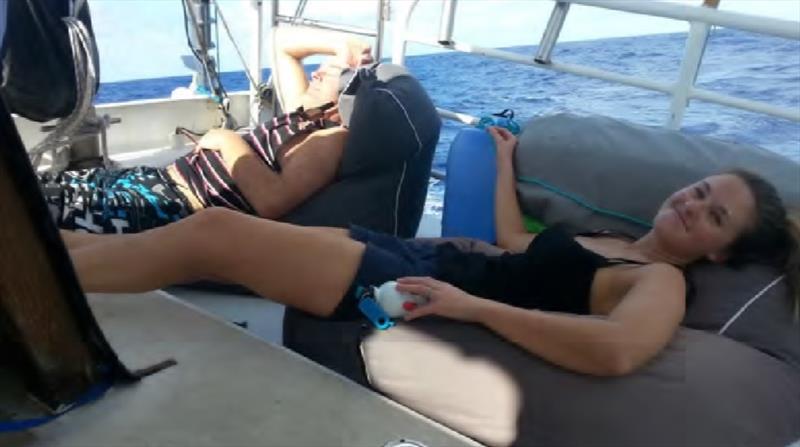
Considering the safety manual for your boat
by Nigel Richards / Island Cruising NZ 3 Mar 2019 03:02 UTC

Daylight Sailing rules enjoying the sun © Island Cruising NZ
Since the publication of the latest edition of the Yachting New Zealand Safety Regulations of Sailing 2017 2020, was released I have received a number of requests on how to develop the Yacht Manual as required in Section 21.
As with all items linked to achieving a satisfactory safety inspection, contact your Cat 1 Inspector for advice on what they will expect to see and be satisfied with in your individual circumstances. However, there are still some basics that we can look at when preparing the document.
Firstly, what is it for? Primarily it is about providing information to the crew to make them safer when operating your vessel. As I have mentioned in previous articles it is all about risk identification and operational procedures. All of you out there whom have a role in the workplace to make safe work environments already know the doctrine I'm about to mention.
Remove, isolate or reduce the effect of the hazard. With operating procedures, list in a chronological order how to safely carry out any particular function. Let us look at some examples. On most sailing vessels one of the major risks we face could be being hit by an uncontrolled boom. Unfortunately, that event can result in serious injury or loss of life. But on some vessels the boom can present little risk.
On my boat for example the goose-neck sits 2.2m above the deck, so unless I employ the services of an NBA Allstar as crew, there is minimal risk from being hit by the boom. However, the genoa clew is a different matter, that swinging around the foredeck with a flapping headsail could easily ruin your day. So how do I record that.
Firstly with the boom. When crew go forward to reef the slab mainsail, other that instructions about safety equipment, they do not leave the cabin-top lower level for any reason during the activity, as all lines and winches are at the goose-neck. The genoa stays hard on the wind as we can reef under load.
However, if the situation changes and the genoa needs to be trimmed, the forward hands have to sit down on the deck to avoid the flapping clew. A similar approach to any work required at boom level is that the boom must be fixed in two directions before leaving the lower cabin-top level. i.e. the mainsheet tight against a strop to the strong point on the gunwale to create a triangle, therefore stopping the boom from coming back and hitting the crew on the cabin-top.
All this is recorded as operational procedures in the Boat Manual. We have identified aboard our vessel that the only area of the side-decks where there is a risk of falling over board is at the step from the rear side-deck to main deck level. Here the solid rail, that normally sits at pelvis height is reduced to knee height as one makes the step down.
The control measure for this is the jackline. It leaves the aft-deck hoop at chest height and goes all the way forward, the crew are on inside of it as they make the step down, tethered of course.
In fact the jack-line pushes you inboard at the crucial moment. Again, this is recorded as an operational procedure in the Manual, forming part of the rules for activities outside the cock-pit area. On the subject of the cock-pit or con. Because we have an enclosed pilothouse, our rules around safety equipment may differ from other open cock-pit boats. I would expect that most skippers will dictate that hands leaving the cabin into the cock-pit must be wearing their lifejacket and clipped on before leaving the companion-way.
I would certainly hope that is the rule, particularly at night! This must be recorded as a procedure. Our rules are different; the night-watch can be safely inside the pilothouse, without the need to wear a lifejacket, but a personal AIS MOB transmitter is a must. Only when exiting to the aft-deck is a lifejacket and tether required, before stepping outside.
During the day, sunning on the aft-deck is allowed without tether if we are under light wind sailing rules, but as soon as the wind pipes and the second reef is required, on go the harnesses or lifejacket and tether when wave gazing from the aft-deck. All recorded in the Manual under the Sailing Rules. We have rules for Daylight Sailing and Darkness Sailing, within those headings are Light Conditions and Heavy Condtions.
These are denoted by the number of reefs in the mainsail; two reefs denote heavy conditions. So, I hope you can see, this not a Manual that you can create to cover all boats and their risks.
You really need to write the manual for each individual boat. Of course applying the same risk assessment and control measure principles are a must. On the next page are a couple of examples from Varekai's manual to see how I've written our procedures. The vessel is described in a narrative form, a little like reading a book. And the final note is this document greatly assists your crew briefing when they get aboard.
Give 'em the manual to read before you start talking. It will give them a basis of how the boat works, see that you know your stuff and generate questions to ensure everybody is on the same page, clued up and ready for a safe passage to somewhere warm. Safe sailing.